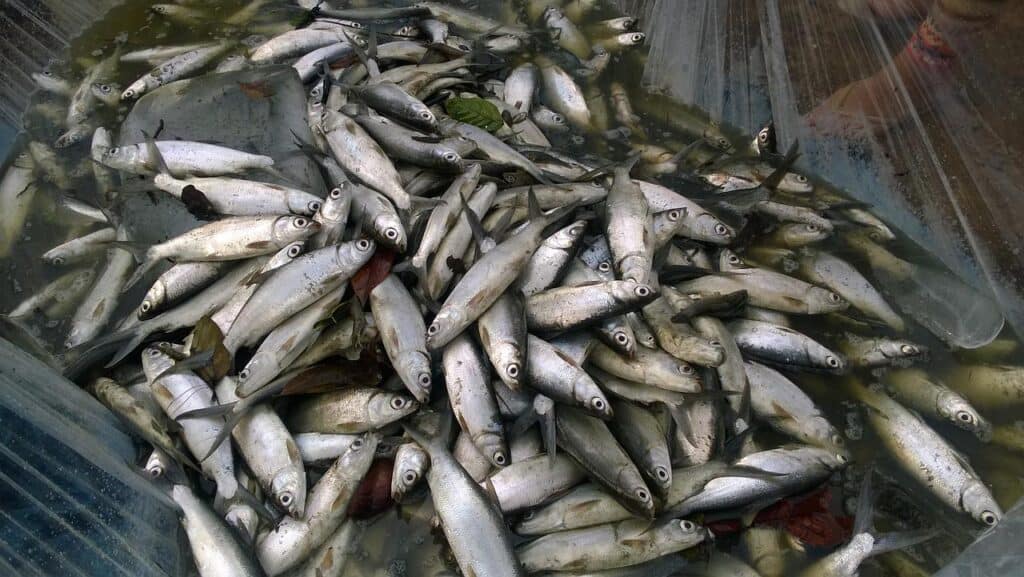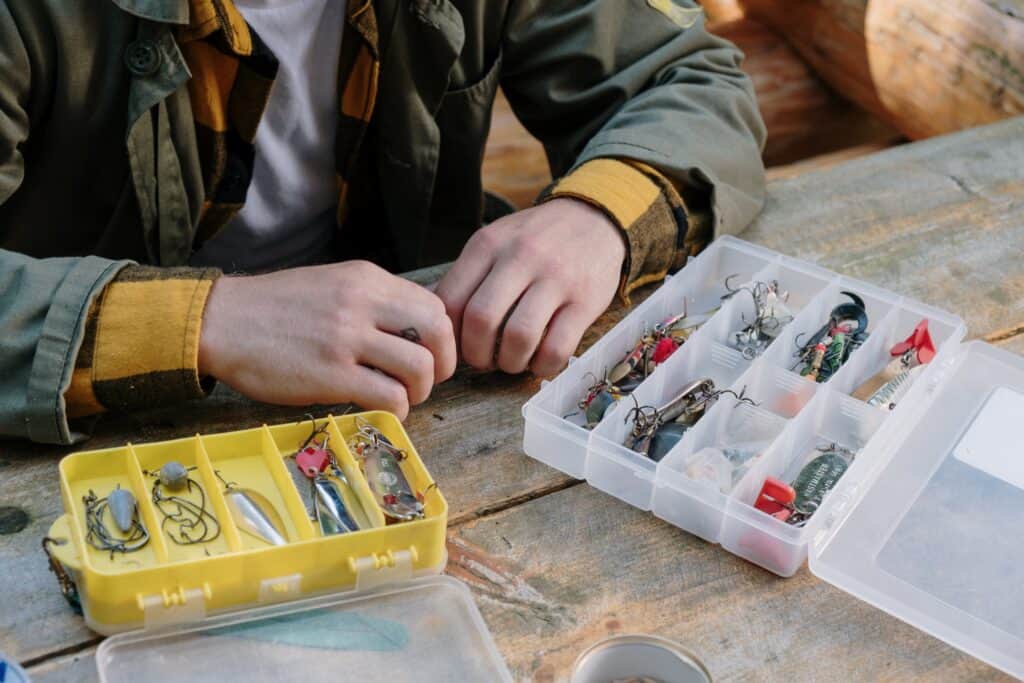
You found them.
Finally.
At first glance, they look like a school of mullet. An undulating mass of toothless, open-mouthed fish gulping at the surface. But unlike mullet, these fish are sparkling silver in color. And their EYES. They have HUGE EYES. Plus, they are three, four, or five times the size of mullets.
Ah, you get excited. You’ve been looking for a school of these Milkfish, and you are prepared.
You’ve already got your heaviest rod. Your limey-green Milky Dream is already tied on. You put on extra line, too. (You know you’ll need it if you can hook one.)
You’ve been wanting one of these fish for the three-in-one experience they give–arial leaps like a tarpon, powerful runs like a permit, and line-eating, deep-dives like a tuna.
Here’s your chance to get a Milkfish on the fly…
All About the Milkfish
Milkfish are becoming more sought after by saltwater fly anglers. They are often called Chanos Chanos or the fork-tailed devil. Less common terms, at least in the flyfishing world, include awa, bangus, banden, or bolu.
They are the last living species in the Chanidae family–all others are extinct. While these are considered a food fish in the Philippines and other local waters, they still have a stable population suitable for sportfishing. Perhaps their success at being commercially farm-raised has protected their numbers in their natural environments.
Milkfish have freaky-large eyes and disproportionately long tails. These gleaming silver, toothless-torpedoes look like a super-sized minnow–like a 6-foot-long minnow!
However, most catches are between 1-3 feet. Regardless of their length, these bullet-shaped fish sure don’t fight like any minnow!
They are frequently accepted as the most powerful fish you can catch by fly.
Milkfish have become one of the most sought-after game fish on the planet, not only because of their fighting ability but also because of the challenge of catching them. So many anglers come all the way to the Seychelles just to target these fish, and sadly most of the time they go home with nothing but pulled hooks and snapped leaders with no fish in the net. This is why every Milkfish landed is a memorable and celebrated occasion.
–Jako Lucas
Where to Find Milkfish
So where do you find them?
Milkfish are native to the Indian Ocean and the Pacific Ocean.
You’ll find them in Seychelles, Christmas Island, South Africa, Madagascar, Northern and Western Australia, California, Hawaii, and, surprisingly, in the colder waters of the Galapagos.
However, they are most common in tropical waters around islands. Because of lifecycles, they are often found around the mouths of rivers. Milkfish are known to spawn and begin their life in open waters but migrate to the shallow, often brackish waters of the protected rivers to mature. The juvenile milkfish will find refuge and the shallow waters and mangrove roots before heading back into deeper water as a young adult.
Many of the most respected fly-fishing resorts and guides are seeing an increased interest in these fish because they bring the perfect combo of a true challenge and an exhilarating experience.
It may also help that there has been some advancement in understanding what type of flys these fish respond to, making the chance of actually getting one of these fish actually plausible. Not likely, but plausible.
If you’re looking for a similar aerial performer closer to home–perhaps one you can catch comfortably from the deck of your Scout boat–seek out a tarpon. Or, if it’s the challenge of getting a hook you are looking for, the Grey Triggerfish will satisfy most challenge seekers.
Picking the Right Water
For the larger fish, adventure beyond the flats into the deep waters.
Yes, you may see a large milkfish in the flats, but the chances of getting one to take a fly in these shallow waters aren’t usually worth pursuing except for younger fish.
However, if you do decide to work the flats, you’ll use similar techniques to that of fishing for bonefish.
Usually, better luck is found in deep water just past the reef. Here, you’ll find Milkfish in schools. LARGE schools–perhaps thousands of fish–all fanatically feeding. Some call them “vegetarian” fish, but the truth is they swallow up what they find. Algae and plankton, but also small fish, copepods, and tiny invertebrates.
It’s helpful to know the waters well enough to know what they are feeding on during the season.
Tides may be less influential when looking for schooling Milkfish than, say, a Yellowmargin Triggerfish. But it’s notable that the spring tide brings in a concentration of plankton, which the milkfish will congregate for. And Neap tides will allow for longer fishing days if heading out to the shallow flats.
Packing the Tacklebox

These fish are big, strong, and feisty fighters. To actually land one, you’ll need the right equipment.
For deep-water schooling Milkfish, grab yourself a 10 to 12-weight rod and pair it with a high-performance saltwater reel with a smooth, dependable drag. You’ll want a floating tropical line (and LOTS of it). You’ll also want a tapered leader, 20-30 lb.
Algae-style flies are popular choices. Consider having a variety of flies that float at different levels from the surface as well because they’ll need to float in just the right part of the water column.
Varieties of green–olive to chartreuse–are favored choices, but it’s best to make your decision based on your local waters. But the truth is, they won’t be nearly as picky about your fly as a predatory fish who likes to take an up-close look at a meal that has the capability of biting back.
Flies that are specifically designed for Milkfish will have a strong hook to stand up to the incredible strength of these large and powerful fish.
If you are fishing the flats, you can drop down to an 8 to 9-weight rod.
Tips for Catching Milkfish on a Fly
The key takeaway is that these are not predator fish.
They basically feed by swimming around with their mouths wide open, snuffling down whatever floats in. They aren’t going to get excited by or take chase toward your fly. Imagine these fish more like mini-me basking sharks or mega-sized mullets.
While the above description may make them sound docile and tame, they are anything but.
These are one of the strongest fish you’ll catch on the fly.
They have a characteristic pattern to their fight once hooked. They’ll start with a thrilling and decidedly chaotic reaction that includes aerial jumping and flailing like a tarpon.
Not once, but repeatedly.
Once that tantrum is over–and if they haven’t wrapped the line around their tail and broken it–they’ll scoot with determination for the deeper, open waters and break away from the school. Finally, the milkfish will pull out all the stops and dive straight down. If they haven’t spooled you yet, they just might now.
Casting accuracy counts. As stated before, these fish aren’t too inclined to swim toward your fly. You’ve got to present it right in front of them. (Fortunately, with a large school, your chances go up.) You’ll probably be doing lots of casting for the day.
Keep in mind, these are not aggressive feeders, say, like a Moustached Triggerfish. In fact, they show more interest in a fly that is floating down towards them–like the algae and marine bits they are accustomed to eating. This unique fly behavior is probably more important than the specific fly choice.
If you’re lucky enough to see the take, wait for them to turn and set the hook…the fun is just a second away!
Newsworthy Notes About the Milkfish
While it is often said that Milkfish can fight longer and harder than others because they don’t build up lactic acid in their muscles, a recent scientific study bunks that myth.
Milkfish do build up lactic acid in their muscles. The study was performed with a partnership of Alphonse Fishing Company, Blue Safari, scientists from the University of Massachusetts Amherst, and Carleton University.
Not only do the fish produce lactic acid, but allowing a fight to continue for more than an hour puts the Milkfish at risk as it impairs their muscle activity, thereby interrupting their feeding pattern and putting them at higher risk from predators.
They suggest that species-specific best practices should include limiting fight times to less than 30 minutes. They recommend that the easiest way to try to shorten the fight time is by increasing your fly rod weight.
Fishing with Scout Boats

You don’t have to travel around the world in search of exhilarating flyfishing experiences. Scout boats opens this world up for their owners every day.
But Scout is more than just a flats boat. Our luxury models range from 17 feet to 53 feet, from center consoles ideal for enjoying the day on the water with friends and family to seaworthy tenders ready to take on any adventure.
To get an idea of the build and design processes that set us apart, take a closer look at our superior manufacturing processes. For example, see our cutting-edge Epoxy Infusion and Carbon Epoxy Construction techniques.

